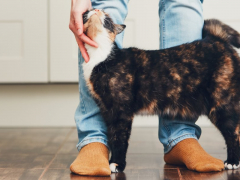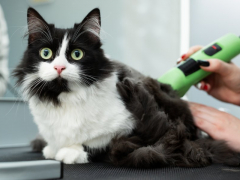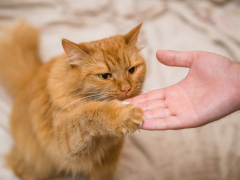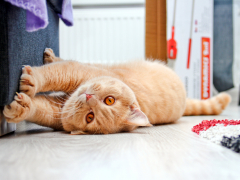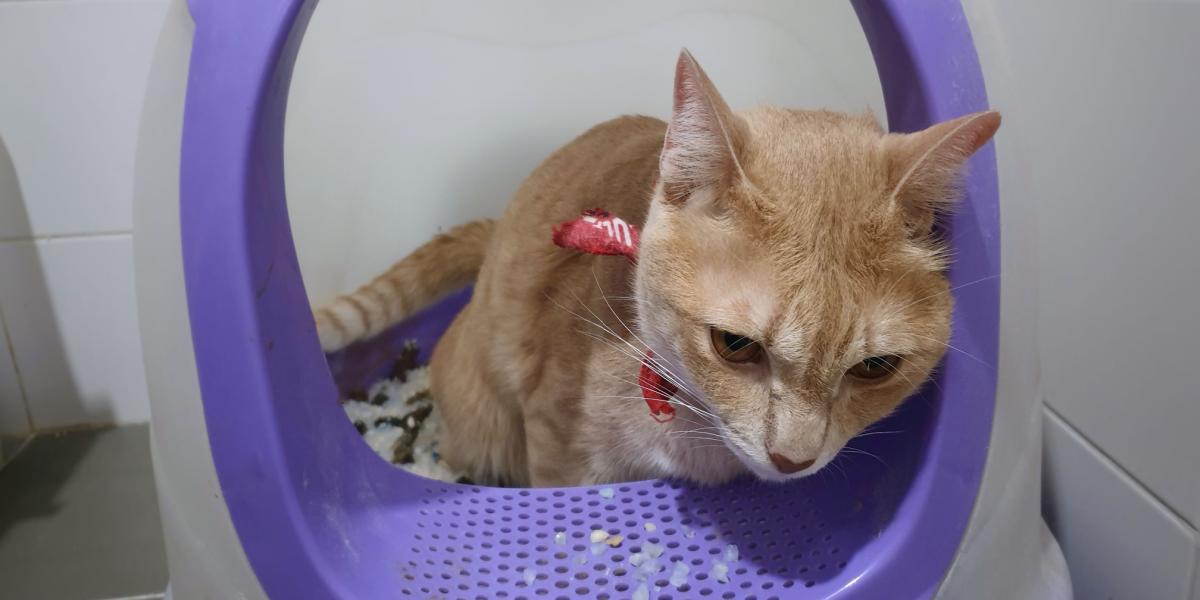
In this article, we will discuss colitis in cats. This article will provide a simple, clear explanation of colitis for cat owners whose pets may be affected, and what can be done to help a cat suffering from this condition.
Quick Overview: Disease Summary






What Is Colitis?
Colitis is defined as inflammation of the colon, which makes up the largest part of the large intestine, connecting the lower small intestine to the rectum and anus. The colon is a common location for digestive disturbances to originate.
The colon has three parts: ascending, transverse, and descending. Together they form an inverted U-shape. The name “colitis” is derived from the prefix “colon,” describing the anatomical location. The suffix “-itis” means “inflammation.” In colitis, some or all of the colon becomes inflamed.
Inflammation describes the way that the body reacts when challenged with any sort of irritation. It is the main way that the immune system defends the body. There are many possible causes of inflammation, including infections, irritation, and allergies. Inflammation results in swelling, heat, redness, pain, and lack of function. So in colitis, all of these issues affect the colon, resulting in uncomfortable and worrying signs of illness.
Also Read: Cat Digestive System: Anatomy, Diseases, & Treatment
What Causes Colitis?

There are a number of possible causes of colitis in cats, and veterinary intervention is often necessary.
Colitis can be caused by anything that results in inflammation of the colon. Common causes include:
- Food allergies (causing inflammatory bowel disease or IBD which can affect the colon as well as other parts of the intestines)
- Ingestion of any irritant substance
- Side effects of medication
- Viral infections
- Bacterial infections
- Intestinal parasites such as roundworms
- Protozoal infections such as Giardia
- Physical irritants such as foreign objects
- Other diseases of the gastrointestinal tract, such as tumors
Also Read: Megacolon In Cats: Causes, Symptoms, And Treatment
Symptoms of Colitis in Cats
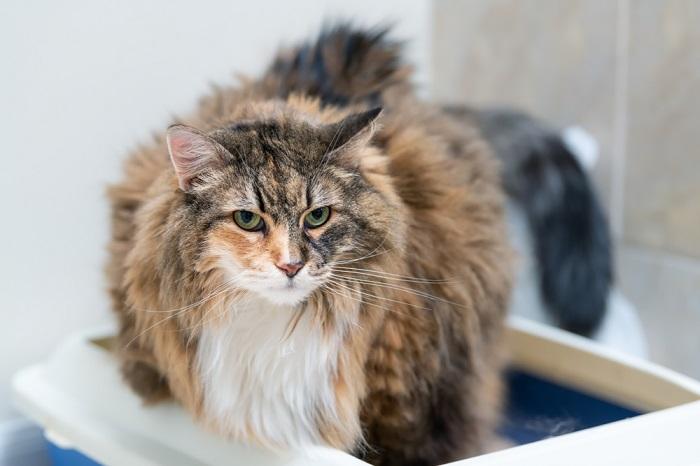
Diarrhea is often a tell-tale sign of colitis in cats.
Colitis is a common cause of large intestinal diarrhea in pet cats, especially in older cats. The main sign of colitis is diarrhea. This can be acute colitis (short-term) or chronic colitis (carrying on for days, weeks, or months).
Colitis causes a particular type of diarrhea known as “large bowel diarrhea.” It’s important to understand the difference between the two main types of diarrhea in cats.
1. Small intestinal diarrhea (caused by small intestinal dysfunction) tends to be produced in larger pools of more watery feces, passed occasionally.
2. Large bowel diarrhea (originating from the colon) tends to be smaller amounts of less watery feces produced more often, sometimes with jelly, mucus, and traces of blood.
If your cat passes diarrhea, take a photo of it to show your vet. Collect a sample to bring to your cat’s vet appointment as well.
With colitis, as well as large-intestinal type diarrhea, the following signs may be seen:
- Tenesmus (straining to pass feces)
- Increased urgency to pass feces
- Accidents e.g. outside the litter box, or inside the cat flap (caught short on the way to going outside to carry out defecation)
- Increased flatulence may be noted
- Weight loss
Also Read: My Cat Doesn’t Finish Pooping In Litter Box: Is This Normal?
Diagnosis of Colitis
If your veterinarian suspects that your cat may have colitis, the following steps may be taken.
1. Detailed History Taking
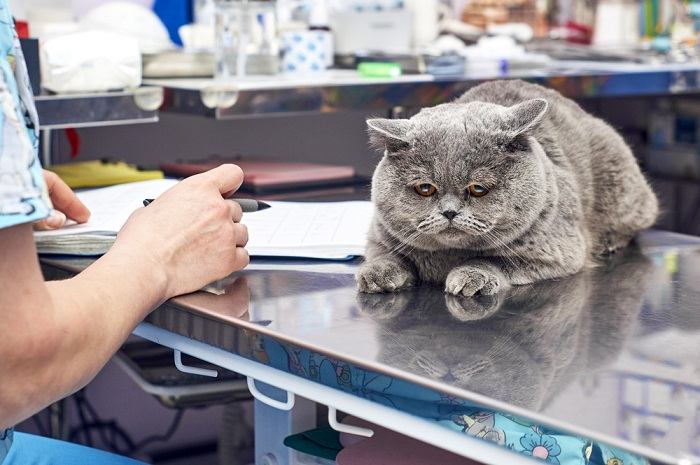
If your cat’s colitis does not pass in 24-48 hours, it’s time for a trip to the veterinarian.
Your vet will discuss every aspect of your cat’s condition and overall health care, looking for clues about why your pet is unwell, and in particular finding out about anything that might affect the digestive system.
This will include asking about your pet’s vaccination status, dietary history (including any supplements given), parasite control program, contact with other cats, and toileting habits.
Also Read: How Many Litter Boxes Should You Have Per Cat?
2. Physical Examination
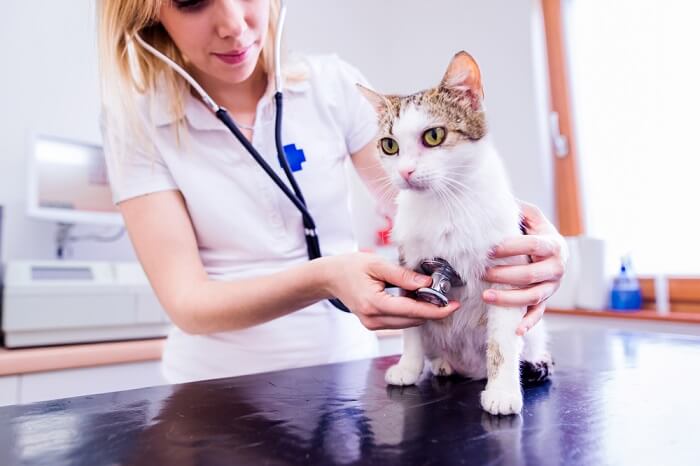
A more thorough examination is necessary for cases of acute colitis.
Your veterinarian will carefully check your cat’s condition all over their body. This includes an inspection of the mouth and teeth, careful palpation of the abdomen, listening to the chest and abdomen with the stethoscope, and an inspection of the anal area.
Occasionally, the nature of trace of feces on a thermometer may be inspected after the temperature has been taken. In colitis, mucus, jelly, and traces of blood are often seen in the feces.
Also Read: What To Do If You See Blood In Your Cat’s Stool?
3. Routine Blood Tests, Urinalysis and Fecal Analysis
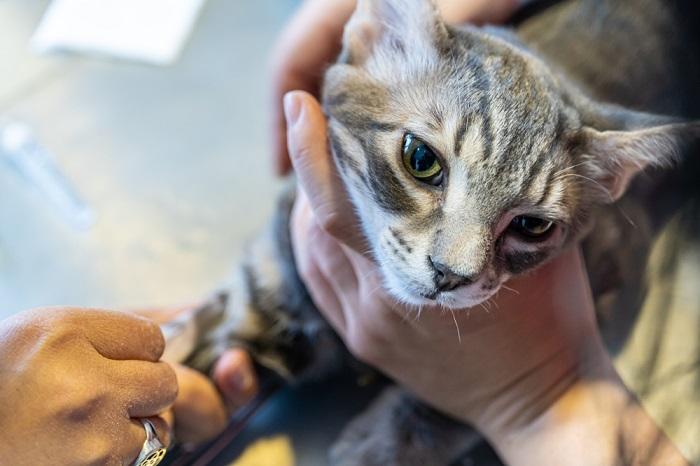
An analysis of the cat’s blood, feces, and urine is routine when looking into a cat’s colitis symptoms.
It’s very likely that your veterinarian will carry out blood work, including the usual panel of diagnostic tests. This includes hematology and biochemistry profiles.
Typically in colitis, there may not be many abnormalities. However, electrolyte imbalances may be identified. Importantly, other causes sharing the same signs of illness will be ruled out, such as liver disease, kidney disease, pancreatitis, feline infectious peritonitis, etc. This is because the blood parameters reflecting these areas of the body will usually be normal, indicating that your cat’s health is generally good.
Blood tests are also useful to assess your cat’s level of hydration. This is important as dehydration is common in cases of diarrhea.
The cat’s thyroid hormone level may be assessed, as hyperthyroidism can cause signs of diarrhea that mimic colitis.
Urinalysis will be carried out as with many other sick cats, as part of a general investigation.
Fecal analysis may include standard fecal flotation and examination, stained cytology for parasites and bacteria, as well as checking for abnormal blood cells. PCR analysis of feces may be used to check for specific pathogens.
Also Read: Best Cat Food For Hyperthyroidism
4. Specialized Blood Tests
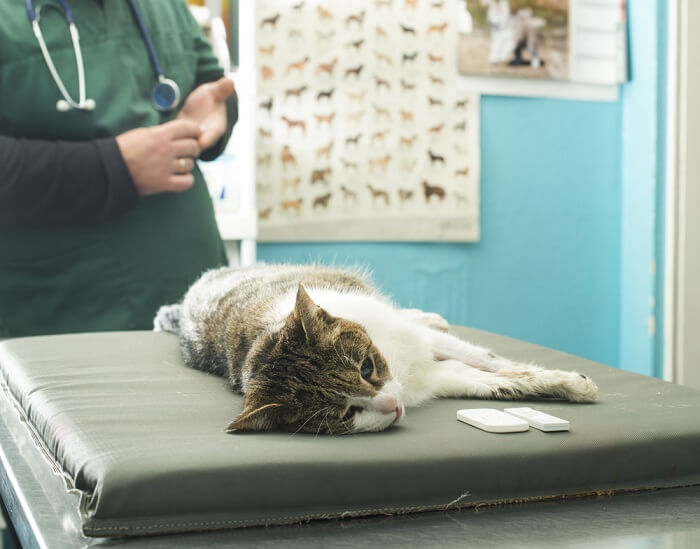
Other serious conditions can be linked to a cat suffering from colitis.
Your veterinarian may recommend specific blood tests for some viral infections such as Feline Leukemia Virus (FeLV) and Feline Immunodeficiency Virus (FIV). These conditions may be linked to the underlying cause of colitis and there are significant implications if your cat is positive for either of these.
5. Other Tests
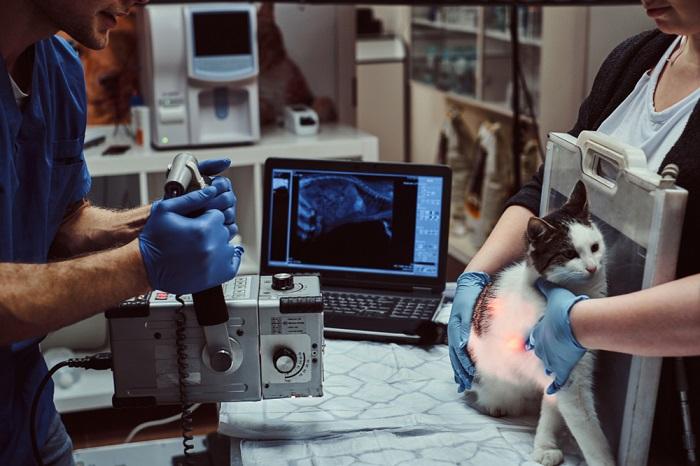
X-rays and ultrasounds provide a deeper look into what may be causing colitis in your cat.
Finally, other tests may be run when your cat comes to the vet with a case of colitis. Radiographs (x-rays) may be taken of the abdomen to check for other causes of colitis, such as the presence of foreign bodies. X-rays can also reveal if there is any unusual build-up of fecal material in the colon.
An ultrasound can be a useful way of assessing the structure of abdominal organs, again making sure that everything else is normal. This can also be used to evaluate aspects of the colon, such as the thickness of the colon wall.
An endoscopy may be carried out to view the internal structure of the mucosal lining of your cat’s colon. In some cases, a biopsy helps make a definitive diagnosis of the type of colitis your cat may have by examining the structure of the colon under the microscope.
Your veterinarian will advise you on which detailed investigations are needed.
Also Read: Cat Body Temperature: Causes & Treatment of Abnormal Body Temperature
Treatment

Sometimes a special diet is enough to help a cat with mild colitis.
Mild cases of colitis may be treated with a general, “cure-all” treatment for GI tract disease without full investigations as listed above. In one study of cats with signs of colitis, around half of the cases responded to nothing but changing to a special bland diet. There are two possible approaches to this.
One approach uses a special diet that helps rule out dietary allergies and intolerances. Allergies are caused by a reaction to a specific protein antigen, while intolerances are reactions to dietary ingredients such as preservatives or food coloring. Beef, wheat, and corn are the most common allergy-inducing proteins.
Suitable diets consist of either a “novel protein” diet or a “hydrolyzed diet.” A novel protein diet consists of proteins that the cat is unlikely to have encountered before (such as certain fish species or unusual meat, like venison). A hydrolyzed diet uses one protein source (such as soy, rice, or potato) which has been digested (hydrolyzed) in the factory to create low-molecular-weight short-chain protein derivatives that are both highly digestible and have a very low antigenic challenge.
Also Read: Elimination Diets For Cats: What You Need To Know?
Alternatively, some cats with colitis respond to diets containing highly fermentable fiber, such fructooligosaccharides. These are also known as “prebiotic diets,” which promote “good” bacteria while inhibiting some “bad” bacteria.
Soluble fiber such as psyllium can also be added to regular diets as a separate supplement.
General treatment for parasites may be given, using anthelmintics such as fenbendazole or pyrantel.
Probiotics can reseed the colon with healthy bacteria, as bacterial populations of the digestive tract make a significant contribution to the digestive processes.
Occasionally, an antibiotic trial may be undertaken using a product such as metronidazole which has anti-inflammatory and antibiotic properties. Some cats with colitis seem to have antibiotic-responsive diarrhea (ARD), a condition formerly known as small intestinal bacterial overgrowth (SIBO). In these days of cautious antibiotic stewardship, it’s more likely that dietary therapy and probiotics will be recommended before resorting to antibiotics.
If a cat with colitis does not respond to this general treatment, then a full, detailed investigation may need to be carried out, including a biopsy to make a specific diagnosis of the cause of the colitis.
The biopsies may show, for example, specific inflammatory cells in the wall of the colon which define the colitis as a particular type, such as lymphocytic-plasmacytic, eosinophilic, neutrophilic, or granulomatous enteritis.
Typically, for colitis caused by inflammatory bowel disease (i.e. when inflammatory cells are identified in inflamed areas of the colon), anti-inflammatory or immunosuppressive medication may be given, such as corticosteroids or stronger immunosuppressive drugs.
Other diseases e.g. tumors (such as lymphoma) can be diagnosed by biopsy, and these may require surgical intervention, chemotherapy, or other approaches.
Also Read: How To Keep Your Cat From Jumping After Surgery
Monitoring and Prognosis
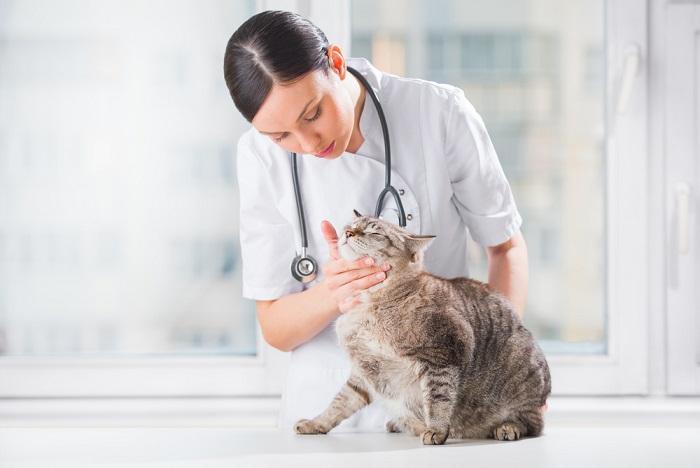
Monitor your cat closely as they recover from colitis. Most cats respond well to the appropriate treatment for the condition.
Your veterinarian will advise you on what follow-up care is needed, but in general, monitoring your pet for further signs of large bowel diarrhea is the main way to confirm that a full recovery is underway.
The prognosis for most cases of colitis is very good, although if a tumor is present, this may not be the case.
Home Remedies
Home interventions are generally limited to a dietary approach, such as offering novel protein diets. These diets consist of proteins that the cat is unlikely to have encountered before (such as certain fish species or exotic meat, like venison). Hydrolyzed diets can also help. These are created using one protein source (such as soy, rice, or potato) which has been digested (hydrolyzed) in the factory to create low-molecular-weight short-chain protein derivatives that are both highly digestible and have a very low antigenic challenge.
Colitis in Cats: Final Thoughts
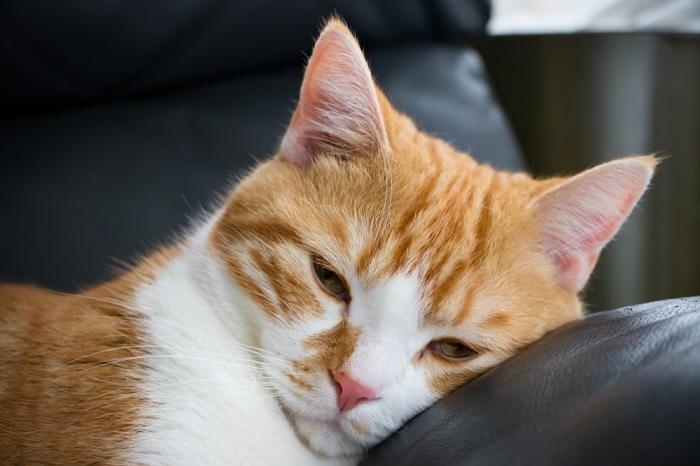
Colitis can be a sign of a serious condition, which may need to be ruled out before proper treatment can be administered.
Colitis is a common cause of large bowel diarrhea in cats. In simple cases, treatment can include special diets. If the problem continues, veterinary intervention is important.
Also Read: The 9 Best Cat Foods For Diarrhea
Frequently Asked Questions
How long does colitis last in a cat?
A simple bout of colitis caused by perhaps a reaction to a particular food may only last 24 - 48 hours. If the signs of colitis go on for longer than this, it's important to take your cat to visit your veterinarian.
How do you treat colitis in cats?
A simple case of colitis can be treated by offering a bland, highly digestible food for 24 to 48 hours. If a cat continues to show signs of colitis, veterinary intervention is essential to identify the underlying cause.
-
Guilford WG, Jones BR, Markwell PJ, Arthur DG, Collett MG, Harte JG. Food sensitivity in cats with chronic idiopathic gastrointestinal problems. J Vet Intern Med (2001) 15:7–13. 10.1111/j.1939-1676.2001.tb02291.x




